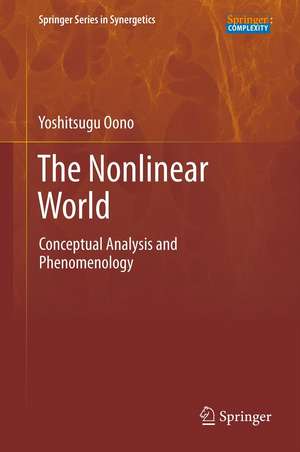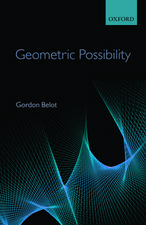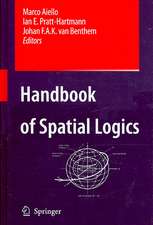The Nonlinear World: Conceptual Analysis and Phenomenology: Springer Series in Synergetics
Autor Yoshitsugu Oonoen Limba Engleză Hardback – 30 oct 2012
| Toate formatele și edițiile | Preț | Express |
|---|---|---|
| Paperback (1) | 641.20 lei 43-57 zile | |
| Springer – 9 noi 2014 | 641.20 lei 43-57 zile | |
| Hardback (1) | 647.40 lei 43-57 zile | |
| Springer – 30 oct 2012 | 647.40 lei 43-57 zile |
Din seria Springer Series in Synergetics
- 15%
 Preț: 653.14 lei
Preț: 653.14 lei - 17%
 Preț: 430.21 lei
Preț: 430.21 lei - 17%
 Preț: 495.46 lei
Preț: 495.46 lei -
 Preț: 392.37 lei
Preț: 392.37 lei -
 Preț: 396.02 lei
Preț: 396.02 lei -
 Preț: 400.10 lei
Preț: 400.10 lei -
 Preț: 391.02 lei
Preț: 391.02 lei - 15%
 Preț: 641.38 lei
Preț: 641.38 lei - 18%
 Preț: 739.00 lei
Preț: 739.00 lei - 15%
 Preț: 645.60 lei
Preț: 645.60 lei - 15%
 Preț: 637.75 lei
Preț: 637.75 lei - 18%
 Preț: 727.31 lei
Preț: 727.31 lei - 20%
 Preț: 481.77 lei
Preț: 481.77 lei -
 Preț: 398.15 lei
Preț: 398.15 lei - 18%
 Preț: 742.97 lei
Preț: 742.97 lei -
 Preț: 416.64 lei
Preț: 416.64 lei -
 Preț: 397.76 lei
Preț: 397.76 lei -
 Preț: 391.99 lei
Preț: 391.99 lei - 15%
 Preț: 644.49 lei
Preț: 644.49 lei -
 Preț: 386.99 lei
Preț: 386.99 lei - 20%
 Preț: 574.08 lei
Preț: 574.08 lei -
 Preț: 387.58 lei
Preț: 387.58 lei - 15%
 Preț: 533.53 lei
Preț: 533.53 lei -
 Preț: 396.02 lei
Preț: 396.02 lei -
 Preț: 390.25 lei
Preț: 390.25 lei -
 Preț: 392.37 lei
Preț: 392.37 lei -
 Preț: 396.40 lei
Preț: 396.40 lei -
 Preț: 408.16 lei
Preț: 408.16 lei - 18%
 Preț: 1116.09 lei
Preț: 1116.09 lei -
 Preț: 397.76 lei
Preț: 397.76 lei - 18%
 Preț: 971.64 lei
Preț: 971.64 lei - 15%
 Preț: 644.30 lei
Preț: 644.30 lei -
 Preț: 386.81 lei
Preț: 386.81 lei -
 Preț: 398.15 lei
Preț: 398.15 lei
Preț: 647.40 lei
Preț vechi: 761.65 lei
-15% Nou
Puncte Express: 971
Preț estimativ în valută:
123.88€ • 129.67$ • 103.11£
123.88€ • 129.67$ • 103.11£
Carte tipărită la comandă
Livrare economică 31 martie-14 aprilie
Preluare comenzi: 021 569.72.76
Specificații
ISBN-13: 9784431540281
ISBN-10: 4431540288
Pagini: 312
Ilustrații: XII, 300 p.
Dimensiuni: 155 x 235 x 22 mm
Greutate: 0.61 kg
Ediția:2013
Editura: Springer
Colecția Springer
Seria Springer Series in Synergetics
Locul publicării:Tokyo, Japan
ISBN-10: 4431540288
Pagini: 312
Ilustrații: XII, 300 p.
Dimensiuni: 155 x 235 x 22 mm
Greutate: 0.61 kg
Ediția:2013
Editura: Springer
Colecția Springer
Seria Springer Series in Synergetics
Locul publicării:Tokyo, Japan
Public țintă
Professional/practitionerCuprins
Looking at the Nonlinear World.- Conceptual Analysis.- Phenomenology.- Modeling.- Toward Complexity.
Notă biografică
Professor Oono received his Dr.Eng.. in applied chemistry from Kyushu University in Japan in 1976. After serving as an assistant professor in the Research Institute of Industrial Science at Kyushu University, he joined the physics faculty at the University of Illinois in 1981.
Textul de pe ultima copertă
The most important characteristic of the “world filled with nonlinearity” is the existence of scale interference: disparate space–time scales interfere with each other. Thus, the effects of unknowable scales invade the world that we can observe directly. This leads to various peculiar phenomena such as chaos, critical phenomena, and complex biological phenomena, among others. Conceptual analysis and phenomenology are the keys to describe and understand phenomena that are subject to scale interference, because precise description of unfamiliar phenomena requires precise concepts and their phenomenological description. The book starts with an illustration of conceptual analysis in terms of chaos and randomness, and goes on to explain renormalization group philosophy as an approach to phenomenology. Then, abduction is outlined as a way to express what we have understood about the world. The book concludes with discussions on how we can approach genuinely complex phenomena, including biological phenomena. The main target of this volume is young people who have just started to appreciate the world seriously. The author also wishes the book to be helpful to those who have been observing the world, but who wish to appreciate it afresh from a different angle.
Caracteristici
Conceptual analysis and Phenomenology are illustrated with chaos and phase transitions Contains an explanation of renormalization group theory for ODE and PDE by the author of the approach Provides a critical analysis of complexity to dispel misunderstandings on this topic

















